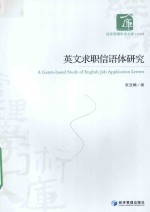
- 作 者:张亚楠著
- 出 版 社:北京:经济管理出版社
- 出版年份:2014
- ISBN:9787509633243
- 标注页数:181 页
- PDF页数:188 页
请阅读订购服务说明与试读!
订购服务说明
1、本站所有的书默认都是PDF格式,该格式图书只能阅读和打印,不能再次编辑。
2、除分上下册或者多册的情况下,一般PDF页数一定要大于标注页数才建议下单购买。【本资源188 ≥181页】
图书下载及付费说明
1、所有的电子图书为PDF格式,支持电脑、手机、平板等各类电子设备阅读;可以任意拷贝文件到不同的阅读设备里进行阅读。
2、电子图书在提交订单后一般半小时内处理完成,最晚48小时内处理完成。(非工作日购买会延迟)
3、所有的电子图书都是原书直接扫描方式制作而成。
Introduction 1
0.1 Research Background 1
0.2 Research Questions 2
0.3 Purpose and Significance 2
0.4 Methodology 3
0.5 Organization of the Book 4
Chapter1 Literature Review 6
1.1 Definitions of Genre 7
1.1.1 Systemic-Functional Perspective 7
1.1.2 ESP Perspective 7
1.1.3 New Rhetoric Perspective 9
1.2 Previous Studies on Job Application Letters 9
1.2.1 Related Studies Abroad 10
1.2.2 Related Studies in China 14
Chapter2 Theoretical Framework 16
2.1 Approaches to Genre Analysis 16
2.1.1 Systemic-Functional Perspective 16
2.1.2 ESP Perspective 19
2.1.3 New Rhetoric Perspective 23
2.2 A Three-Space Model of This Study 25
Chapter3 A Three-Space Analysis of English Job Application Letters 30
3.1 Social Space—Contextual Analyses 30
3.1.1 Context of Culture 30
3.1.2 Context of Situation 31
3.2 Social-Cognitive Space—Generic Structures Analyses 32
3.2.1 Generic Structures of English Job Application Letters by Native Writers 32
3.2.2 Generic Structures of English Job Application Letters by Chinese Writers 38
3.3 Textual Space—Linguistic Analyses 41
3.3.1 Linguistic Analyses of English Job Application Letters by Native Writers 42
3.3.2 Linguistic Analyses of English Job Application Letters by Chinese Writers 47
Chapter4 A Contrastive Analysis of the Two Corpora 51
4.1 Generic Structures and Linguistic Features of the Two Corpora 51
4.1.1 Similarities and Differences of Generic Structures of the Two Corpora 51
4.1.2 Similarities and Differences of Linguistic Features of the Two Corpora 53
4.2 Underlying Causes of the Differences of the Two Corpora 56
4.2.1 Linguistic Factor—Native Language VS.Foreign Language 57
4.2.2 Social Factor—Low-Power Distance VS.High-Power Distance 57
4.2.3 Cultural Factor—Low-Context Culture VS.High-Context Culture 58
Chapter5 Pedagogical Implications:from Theory to Practice 60
5.1 The Teaching Process 60
5.1.1 Building the Context 60
5.1.2 Modeling and Deconstructing this Genre 62
5.1.3 Joint Construction of the Genre 64
5.1.4 Independent Construction of the Genre 66
5.1.5 Peer Assessment 75
5.1.6 Teacher Assessment 78
5.2 Instruction of Cultural Knowledge 79
5.2.1 Necessity and Significance 79
5.2.2 Definitions of Language and Culture 80
5.2.3 Mutual Impact of Language and Culture 81
5.2.4 Suggested Instruction Strategies 82
5.3 The Role of Teachers 84
5.3.1 Teachers as Language Learners 84
5.3.2 Teachers as Researchers 84
5.3.3 Teachers as Coaches 85
5.3.4 Teachers as Coordinators 85
Conclusion 86
Abbreviations 89
Appendices 90
Appendix 1:Corpus A&Corpus B 90
Appendix 2:WordSmith Tools Corpus A&Corpus B 153
Appendix 3:Titles of Common Positions 155
Appendix 4:Names of Common Enterprises 165
Bibliography 172
Postscript 181
